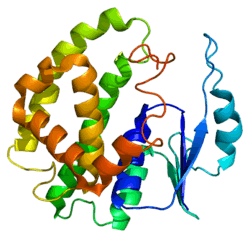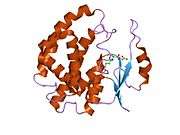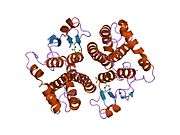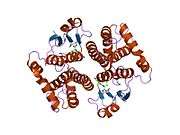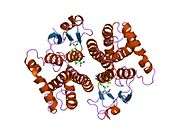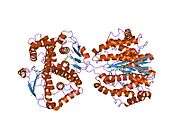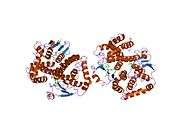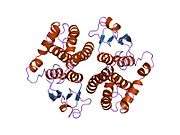GSTM2
Glutathione S-transferase Mu 2 is an enzyme that in humans is encoded by the GSTM2 gene.[5][6][7]
Cytosolic and membrane-bound forms of glutathione S-transferase are encoded by two distinct supergene families. At present, eight distinct classes of the soluble cytoplasmic mammalian glutathione S-transferases have been identified: alpha, kappa, mu, omega, pi, sigma, theta and zeta. This gene encodes a glutathione S-transferase that belongs to the mu class. The mu class of enzymes functions in the detoxification of electrophilic compounds, including carcinogens, therapeutic drugs, environmental toxins and products of oxidative stress, by conjugation with glutathione. The genes encoding the mu class of enzymes are organized in a gene cluster on chromosome 1p13.3 and are known to be highly polymorphic. These genetic variations can change an individual's susceptibility to carcinogens and toxins as well as affect the toxicity and efficacy of certain drugs.[7]
References
- 1 2 3 GRCh38: Ensembl release 89: ENSG00000213366 - Ensembl, May 2017
- 1 2 3 GRCm38: Ensembl release 89: ENSMUSG00000004035 - Ensembl, May 2017
- ↑ "Human PubMed Reference:".
- ↑ "Mouse PubMed Reference:".
- ↑ Vorachek WR, Pearson WR, Rule GS (Jun 1991). "Cloning, expression, and characterization of a class-mu glutathione transferase from human muscle, the product of the GST4 locus". Proc Natl Acad Sci U S A. 88 (10): 4443–7. doi:10.1073/pnas.88.10.4443. PMC 51676. PMID 2034681.
- ↑ Campbell E, Takahashi Y, Abramovitz M, Peretz M, Listowsky I (Jul 1990). "A distinct human testis and brain mu-class glutathione S-transferase. Molecular cloning and characterization of a form present even in individuals lacking hepatic type mu isoenzymes". J Biol Chem. 265 (16): 9188–93. PMID 2345169.
- 1 2 "Entrez Gene: GSTM2 glutathione S-transferase M2 (muscle)".
Further reading
- Bogaards JJ, van Ommen B, van Bladeren PJ (1992). "Purification and characterization of eight glutathione S-transferase isoenzymes of hamster. Comparison of subunit composition of enzymes from liver, kidney, testis, pancreas and trachea". Biochem. J. 286. ( Pt 2): 383–8. PMC 1132909. PMID 1530570.
- Dawson SJ, White LA (1992). "Treatment of Haemophilus aphrophilus endocarditis with ciprofloxacin". J. Infect. 24 (3): 317–20. doi:10.1016/S0163-4453(05)80037-4. PMID 1602151.
- Taylor JB, Oliver J, Sherrington R, Pemble SE (1991). "Structure of human glutathione S-transferase class Mu genes". Biochem. J. 274. ( Pt 2): 587–93. PMC 1150179. PMID 2006920.
- Laisney V; Nguyen Van Cong; Gross MS; Frezal J (1985). "Human genes for glutathione S-transferases". Hum. Genet. 68 (3): 221–7. doi:10.1007/BF00418392. PMID 6500576.
- Raghunathan S, Chandross RJ, Kretsinger RH, et al. (1994). "Crystal structure of human class mu glutathione transferase GSTM2-2. Effects of lattice packing on conformational heterogeneity". J. Mol. Biol. 238 (5): 815–32. doi:10.1006/jmbi.1994.1336. PMID 8182750.
- Anttila S, Hirvonen A, Vainio H, et al. (1994). "Immunohistochemical localization of glutathione S-transferases in human lung". Cancer Res. 53 (23): 5643–8. PMID 8242618.
- Pearson WR, Vorachek WR, Xu SJ, et al. (1993). "Identification of class-mu glutathione transferase genes GSTM1-GSTM5 on human chromosome 1p13". Am. J. Hum. Genet. 53 (1): 220–33. PMC 1682241. PMID 8317488.
- Ross VL, Board PG (1993). "Molecular cloning and heterologous expression of an alternatively spliced human Mu class glutathione S-transferase transcript". Biochem. J. 294. ( Pt 2): 373–80. PMC 1134464. PMID 8373352.
- Baez S, Segura-Aguilar J, Widersten M, et al. (1997). "Glutathione transferases catalyse the detoxication of oxidized metabolites (o-quinones) of catecholamines and may serve as an antioxidant system preventing degenerative cellular processes". Biochem. J. 324. ( Pt 1): 25–8. PMC 1218396. PMID 9164836.
- Xu S, Wang Y, Roe B, Pearson WR (1998). "Characterization of the human class Mu glutathione S-transferase gene cluster and the GSTM1 deletion". J. Biol. Chem. 273 (6): 3517–27. doi:10.1074/jbc.273.6.3517. PMID 9452477.
- Patskovska LN, Fedorov AA, Patskovsky YV, et al. (1998). "Expression, crystallization and preliminary X-ray analysis of ligand-free human glutathione S-transferase M2-2". Acta Crystallogr. D. 54 (Pt 3): 458–60. doi:10.1107/S0907444997011190. PMID 9761928.
- Coles BF, Anderson KE, Doerge DR, et al. (2000). "Quantitative analysis of interindividual variation of glutathione S-transferase expression in human pancreas and the ambiguity of correlating genotype with phenotype". Cancer Res. 60 (3): 573–9. PMID 10676639.
- Luo JK, Hornby JA, Wallace LA, et al. (2003). "Impact of domain interchange on conformational stability and equilibrium folding of chimeric class micro glutathione transferases". Protein Sci. 11 (9): 2208–17. doi:10.1110/ps.0208002. PMC 2373595. PMID 12192076.
- Strausberg RL, Feingold EA, Grouse LH, et al. (2003). "Generation and initial analysis of more than 15,000 full-length human and mouse cDNA sequences". Proc. Natl. Acad. Sci. U.S.A. 99 (26): 16899–903. doi:10.1073/pnas.242603899. PMC 139241. PMID 12477932.
- Ivarsson Y, Mackey AJ, Edalat M, et al. (2003). "Identification of residues in glutathione transferase capable of driving functional diversification in evolution. A novel approach to protein redesign". J. Biol. Chem. 278 (10): 8733–8. doi:10.1074/jbc.M211776200. PMID 12486119.
- De Maria F, Pedersen JZ, Caccuri AM, et al. (2004). "The specific interaction of dinitrosyl-diglutathionyl-iron complex, a natural NO carrier, with the glutathione transferase superfamily: suggestion for an evolutionary pressure in the direction of the storage of nitric oxide". J. Biol. Chem. 278 (43): 42283–93. doi:10.1074/jbc.M305568200. PMID 12871945.
- Gerhard DS, Wagner L, Feingold EA, et al. (2004). "The status, quality, and expansion of the NIH full-length cDNA project: the Mammalian Gene Collection (MGC)". Genome Res. 14 (10B): 2121–7. doi:10.1101/gr.2596504. PMC 528928. PMID 15489334.
- Weng MW, Hsiao YM, Chiou HL, et al. (2005). "Alleviation of benzo[a]pyrene-diolepoxide-DNA damage in human lung carcinoma by glutathione S-transferase M2". DNA Repair (Amst.). 4 (4): 493–502. doi:10.1016/j.dnarep.2004.12.006. PMID 15725629.
